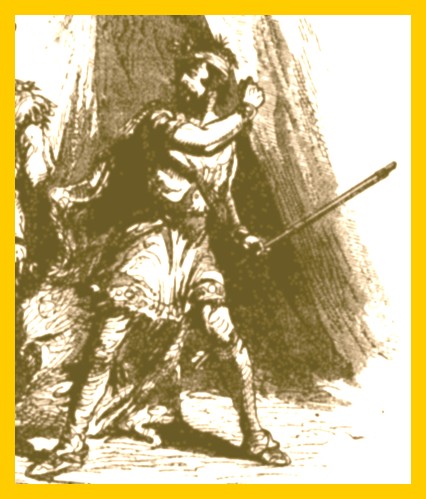A etching that appeared in a book about Simon Girty Jr., The White Savage, published in 1928, and re-published on Wikipedia.
The following story about Simon Girty Jr. appeared in a column, “The History Lesson,” by Lynn Otto, that appeared in the Upper Dauphin Sentinel, 9 September 1987:
Simon Girty
Much has been written and said about the exploits of Simon Girty Jr. Some would say that he was bad through and through. Others would say that he had some good in him. Perhaps we will never know what made this man tick. Let us take a look at his life.
Simon Girty Sr. was a licensed Indian trader on the Pennsylvania frontier as early as 1740. His home was then located in Perry County, and here were born four sons – Thomas Girty, George Girty, James Girty, and Simon Girty.
Because Simon Girty Sr. was a squatter,or living on land he didn’t own, he was chased by the sheriff around 1750 and moved to the east side of the Susquehanna River near present-day Halifax. Simon Girty Sr. had a strong liking for whiskey and was killed in a drunken brawl. In 1756, Mrs. Girty was killed by Indians, and three of the boys were captured by Indians.
George Girty was taken by the Delawares and became a fierce warrior. James Girty was adopted by the Shawnee Nation and became a cruel raider along the Kentucky border, sparing not even women and children from the tomahawk.
Simon Girty Jr. was captured by the Senecas and called “Katepacomen.” It has to be mentioned here that Simon Jr. had to follow the way of the Indians or be killed. He became an expert hunter and tracker, and, in reality, became an Indian.
Simon was taken to the Ohio Territory and there was released as a concession to the close of the Pontiac War in 1764. Although white, Simon preferred to live in the wilds and returned to the Senecas of his own will. Again, as a gesture of friendship, the Senecas returned Simon, and this time, he settled near Fort Pitt. He acted as an Indian agent and courted for the hand of the daughter of Colonel WIlliam Crawford, although he was rejected.
It has to be stated that the great Kentucky scout and long hunter Simon Renton had only good to say about Simon Girty Jr. and even credited him with saving his life.
As the American Revolution took place, Simon was a commissioned militia officer at Fort Pitt. However, for some reason, he deserted to the British cause. It is around this time that he got his bad name. He led many attacks against the people on the frontier with his Indian allies, and many acts of cruelty were recorded.
Perhaps the event for which Girty is remembered the most is against the man whose daughter’s hand Girty had sought — Colonel Crawford. Crawford had mounted an attack against Girty and his Indians but was eventually captured along with his doctor. This episode was recorded through the eyes of Dr. Knight.
Crawford was led to a post, where he was fastened. Wood was piled around the post. The colonel was stripped naked and forced to sit down upon the kindled fire. Crawford pleaded with Girty to help him to be released from his predicament, but Girty would not listen to his friend’s pleas.
Crawford’s hands were tied, and the rope was raised over his head so that his feet were just touching the ground. As the fire grew hotter, Crawford asked Girty to help him or shoot him. Girty replied that he had no pity.
Hot coals were then forced under Crawford’s feet, and he was forced to walk upon the, He suffered for two hours and then fell over. Then he was scalped, and hot coals were laid on his head where the scalp had been taken. Crawford raised himself and walked around until he died.
After the war, Girty fled to Canada, where he lived on a farm until he died in 1819.
What causes a man to do the things which Simon Girty did? Was it his young upbringing among the Indians, emotional scars from his drunken father, or no love shown in his family? We will never know the answers.
Such were the life and times of Simon Girty Jr.
___________________________________
See also:
Corrections and additional information should be added as comments to this post.
